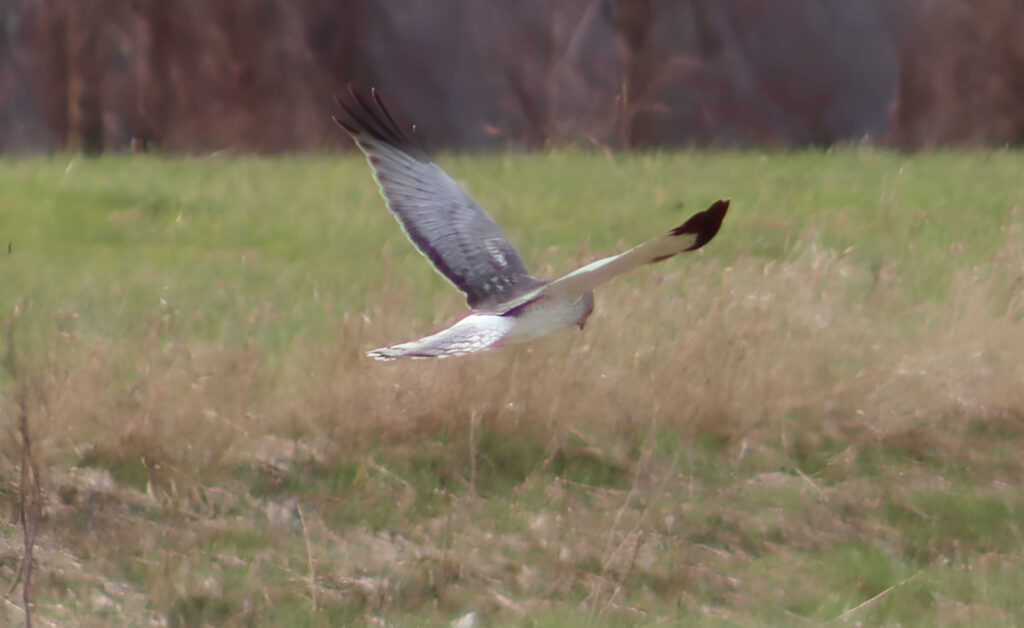Once a common sight, this hawk depends on open fields to survive
By Bob Confer, photo by Dan Jordan
Due to the relatively late start of the last few winters in Western New York, we have been periodically blessed by decent numbers of northern harriers, birds which were once called “marsh hawks”.
Typically, these beautiful hawks aren’t here in any volume in the winter months because the snow inhibits their ability to hunt the open fields for mice and voles, so they head south where it’s not an issue. But, Novembers and Decembers, for the most part, have been snow-free in recent years, so our friends from the north stick around and have a productive time flying over local wheat and alfalfa fields.
Harriers are fairly large birds of prey, coming in at 18 to 24 inches in length. To put that into perspective, the common red-tailed hawk is 19 to 25 inches in length. They look smaller, though, because they aren’t as bulky as red-tails and are more streamlined.

Male harriers have a grey back and lightly-streaked underbelly while females are brown. Both sexes have a white rump patch, which is very noticeable in flight or when the bird is perched on a fence post.
Strictly a bird of wide open spaces (you won’t find them in woods, brush, or backyards), they are easy to identify when they are flying about in search of rodents. They glide, with a slight v-shape to the wings, and it’s that light, ballet-like flight that makes them so fun to watch.
Unlike other hawks which will fly or hover far above a field, or watch that field from a high perch,
harriers hunt close to the turf. Their beautiful maneuvers take place from 2 to 10 feet above the ground. Those low flyovers allow them to catch voles off guard and then pounce on the mouse-like creatures with ferocity. Other open space hawks like red-tails will dive bomb or fall onto their prey from great heights.
Harriers can cover some impressive territory in their hunts and tracking devices have shown that the combined distances of their flights and glides can reach 100 miles per day.
Harriers have disc-like pockets on their faces, just like owls do, which makes for great hearing ability, which adds to their ability to surprise their meals – they don’t necessarily have to see them, they can hear them running through the grasses.
Harriers used to be common birds in WNY’s summers, especially back in the 1940s and 1950s. Even back when I was a kid in the 1980s, I thought they could be seen in okay numbers. But, they’ve been on the decline, with their population dropping as much as 2% per year since the late-1960s. The Department of Environmental Conservation considers them “threatened” in New York. If I see just one of these birds in the summer, I now consider myself very lucky.
Their losses come from a number of factors. Mostly, it’s because of the decline in family farms and those former farms becoming brush or woodlots. Then, the farms that do remain have changed their practices. Nowadays, you see less pasture or hay and alfalfa fields, and more crops like beans and corn in which the ground-nesting harriers will not raise their young. Adding insult to injury, when they do have the chance to breed in the alfalfa and hay fields that do remain, their nests are destroyed by early cuts in June. They can’t recover with a second brood, because some farms are fortunate enough to have 3 or 4 cuttings per summer.

Some birders might cast ire at farms that do this, by blaming them for destroying the harriers. But, look at it this way – the only reason the harriers once nested in volume in Western New York, and the only reason a few here and there can maintain nests nowadays, is the fact that the farms exist. No fields equals no harriers. It’s sort of like a chicken or the egg quandary. In this case, we know that the fields had to come first for these birds: The region was a great forest before the Europeans’ arrival, meaning that there were no harriers here at all.
But, we are blessed to have them here in the present. Although they are a rare sight in the summer
months, they can be seen right now with increased frequency. They will be with us until the snow buries the local fields, which, given the short-term forecast and multi-week weather models, will be soon. So, over the next few days, maybe even the new week or two, while passing through the wide open spaces of rural WNY, pull over to the side of the road and appreciate the low-flying majestic glides of this beautiful predator. They are truly a wonderful sight to behold.
Bob Confer is a Western New York naturalist, writer, TV host, businessman, familyman, and always generous with his knowledge and unique perspective. You can reach him anytime, Bob@ConferPlastics.com
Check out Dan Jordan’s photojournal on this beautiful hawk from earlier this week:






